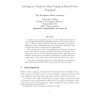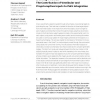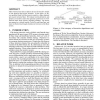91
Voted
CG
2010
Springer
14 years 10 months ago
2010
Springer
We define the Rook Jumping Maze, provide historical perspective, and describe a generation method for such mazes. When applying stochastic local search algorithms to maze design, m...
95
Voted
IJCGA
2010
14 years 11 months ago
2010
Imagine you are trapped in a maze of caves. All you have is an old rusty compass and barely enough light to read it. How much inaccuracy can you allow to ensure that you can leave...
108
Voted
PRESENCE
1998
15 years 14 days ago
1998
In two experiments, subjects traveled through virtual mazes, encountering target objects along the way. Their task was to indicate the direction to these target objects from a ter...
88
Voted
CONCURRENCY
2008
15 years 27 days ago
2008
Much work has been done to address the need for incentive models in real deployed peer-to-peer networks. In this paper, we discuss problems found with the incentive model in a lar...



